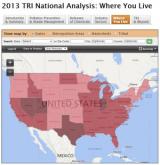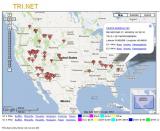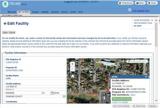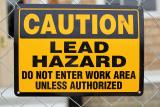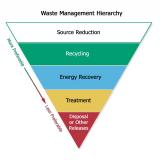EPCRA Milestones Through the Years (Text Version)
View Interactive Timeline | View Text Version Timeline
The Toxics Release Inventory (TRI) Program Marks 30 Years of EPCRA
October 17, 2016
By making information about industrial management of toxic chemicals available to the public, community members, researchers, industrial facilities, investors, and government agencies can make more informed decisions that impact human health and the environment. TRI also creates a strong incentive for companies to reduce pollution and be good neighbors in their communities.
Watch these Videos About the Power of TRI Data.
EPCRA (Non-Section 313) Online Training for States, Tribes, LEPCs, Local Planners and Responders
2016
This training describes the requirements of the Emergency Planning and Community Right-to-Know Act (EPCRA). It provides the implementing regulations and guidance for agencies to fulfill the responsibilities prescribed in the law, and prepares them to provide compliance assistance to facilities.
Chemical Advisory: Safe Storage, Handling, and Management of Solid Ammonium Nitrate Prills
June 2015
EPA, OSHA, and ATF issue a chemical advisory addressing Safe Storage, Handling, and Management of Solid Ammonium Nitrate Prills in June 2015. The safe practices in this advisory should become normal practices for all businesses handling, storing, manufacturing, or blending AN.
How to Better Prepare Your Community for a Chemical Emergency: A Guide for State, Tribal and Local Agencies
June 2015
This guide provides an overview of the EPCRA requirements for State Emergency Response Commissions (SERCs), Tribal Emergency Response Commissions (TERCs), Local Emergency Planning Committees (LEPCs), and Tribal Emergency Planning Committees (TEPCs).
New Interactive Web-Based TRI National Analysis Format
January 2015
EPA makes the annual Toxics Release Inventory (TRI) report available in a Web-based format that features analyses and interactive maps showing data at a state, county, city, and zip code level.
EO 13650: Report for the President -- Actions to Improve Chemical Facility Safety and Security – A Shared Commitment
May 2014
A Report for the President summarizes the Working Group's progress, focusing on actions to date, findings and lessons learned, challenges, and establishes short and long-term priority actions. The report, Actions to Improve Chemical Facility Safety and Security – A Shared Commitment, includes an aggressive Action Plan focusing on changing the national landscape of chemical facility safety and security.
EO 13650: Improving Chemical Safety and Security
August 1, 2013
President Obama issues Executive Order (EO) 13650: Improving Chemical Facility Safety and Security following several catastrophic chemical facility incidents in the US, including the West Fertilizer Explosion and Fire in West, TX. The focus of the EO is to reduce risks associated with hazardous chemicals to owners and operators, workers, and communities by enhancing the safety and security of chemical facilities.
The EO establishes a Chemical Facility Safety and Security Working Group to oversee this effort. The Working Group, which is tri-chaired by the EPA, Department of Labor (DOL/OSHA), and the Department of Homeland Security (DHS), includes leadership and subject matter experts from each of the three agencies. The Working Group member agencies and the broader community of stakeholders have practices, operations, protocols, and policies that address chemical facility safety and security: all recognize that improvement is necessary and requires a shared commitment from all stakeholders. Emergency responders, in particular, have needs to be addressed and capabilities to be strengthened so that they can better manage threats and hazards in their communities.
TRI-MEweb Electronic Forms Submission
August 2013
A final rule requires all facilities that report to the TRI Program to submit their reporting forms using the Web-based TRI-MEweb reporting application. Widespread use of TRI-MEweb improves the quality and accuracy of TRI data and allows EPA to get the data to the public faster.
West, Texas Fertilizer Explosion and Fire
April 17, 2013
A fire at an ammonium nitrate (AN) storage and distribution facility in West, Texas, results in a detonation of fertilizer grade ammonium nitrate (FGAN) stored at the facility. Fifteen are killed, including some of the firefighters responding to the fire. The explosion injures more than 250 and causes extensive damage to nearby homes, businesses, and schools.
TRI Pollution Prevention (P2) Search Tool
January 2013
A new online tool provides access to TRI P2 data, allowing users to compare how different companies have managed their toxic chemical waste. The tool is also a valuable resource that lets companies and industries learn from each other’s P2 best practices.
Increasing Tribal Participation in the TRI Program
April 2012
A final rule requires TRI facilities located in Indian country to submit their TRI reporting forms to EPA and the appropriate tribe, rather than to the state in which the facility is geographically located.
EPCRA 25th Anniversary: Cynthia Giles, Former Assistant Administrator, OECA
October 17, 2011
Compliance with the Emergency Response and Community Right-to Know law is critical to ensuring that local, state, tribal and federal government agencies have the information necessary to plan for emergencies.
EPCRA 25th Anniversary: Lisa Jackson, Former EPA Administrator
October 17, 2011
A quarter-century ago in the aftermath of the tragic Bhopal, India incident, Congress wisely passed and the President signed the Emergency Planning and Community Right-to-Know Act (known as EPCRA) for part of the 1986 reauthorization of Superfund.
EPCRA 25th Anniversary: Mathy Stanislaus, Former Assistant Administrator, OSWER
October 17, 2011
Chemical safety is a major priority at EPA. It has been 25 years since the Emergency Planning and Community Right-to-Know Act, also known as EPCRA, was included in the reauthorization of the federal Superfund law.
EPCRA 25th Anniversary: Malcolm Jackson, Former Assistant Administrator, OEI
October 17, 2011
The Toxics Release Inventory – or TRI – is the world's premier community right-to-know program.
TRI informs communities about toxic chemical releases in their surroundings. TRI provides information on the quantities of toxic chemicals that U.S. facilities release to air, water or land, or otherwise manage through recycling, energy recovery or treatment, on an annual basis.
40th Anniversary of EPA
December 2, 2010
 The US Environmental Protection Agency was founded on December 2, 1970. From that time to the present, America's environmental history has stood witness to both dramatic events and remarkable progress. For 40 years, EPA has worked to safeguard our natural environment and protect human health. Although there is still much left to accomplish, America has made significant strides in reducing the pollution that can threaten the air we breathe, the water we use and the communities where we live.
The US Environmental Protection Agency was founded on December 2, 1970. From that time to the present, America's environmental history has stood witness to both dramatic events and remarkable progress. For 40 years, EPA has worked to safeguard our natural environment and protect human health. Although there is still much left to accomplish, America has made significant strides in reducing the pollution that can threaten the air we breathe, the water we use and the communities where we live.
National Toxicology Program Chemicals Added to TRI
November 2010
A final rule added 16 new chemicals to the Toxic Release Inventory (TRI) Program. Each chemical added is “reasonably anticipated to be a human carcinogen” by the National Toxicology Program (NTP), an interagency government program that works to evaluate public health concerns.
Availability of TRI Data: Earliest-Ever
July 28, 2010
For the first time, TRI data are available to the public within the same month as the reporting deadline, providing communities with earlier access to important toxic chemical information.
 myRTK Mobile App
myRTK Mobile App
June 2010
EPA launches the first TRI mobile application, “myRTK,” providing easier access to and more context for TRI information.
 TRI National Analysis Report
TRI National Analysis Report
December 2009
For the first time, EPA publishes its TRI National Analysis report in the same calendar year that the data are reported to EPA. The National Analysis includes documents and webpages that provide analysis and interpretation of the most recent TRI data, including national and local trends of toxic chemical releases to the environment.
TRI.NET Application Debuts
June 2009
EPA releases the downloadable TRI.NET application to provide advanced mapping and search capabilities to TRI data users.
Omnibus Appropriations Act Restores TRI Reporting Requirements
April 2009
The 2009 Omnibus Appropriations Act restores the more comprehensive TRI reporting requirements that were in effect prior to the 2006 Burden Reduction Rule.
 RMP*eSubmit Software
RMP*eSubmit Software
March 13, 2009
EPA launched a new, easy to use software called RMP*eSubmit for facilities to use for online Risk Management Plan (RMP) reporting.
Nationwide Survey of Local Emergency Planning Committees
May 2008
 EPA conducted a survey of Local Emergency Planning Committees (LEPCs), which followed surveys conducted in both 1994 and 1999 to gauge levels of LEPC compliance and activity.
EPA conducted a survey of Local Emergency Planning Committees (LEPCs), which followed surveys conducted in both 1994 and 1999 to gauge levels of LEPC compliance and activity.
EPA decided to “check the pulse” of LEPCs, with the goals of the survey being:
- Track the progress of LEPCs by assessing their current activity
- Probe current LEPC practices and preferences regarding several issues, including: communication with citizens, accident prevention efforts, and the effectiveness of EPA products and services.
TRI-MEweb Application Available to All Facilities
January 2008
EPA released the TRI-MEweb (Toxic Release Inventory – Made Easy Web) reporting application, allowing all TRI facilities to submit TRI data through the Internet. TRI-MEweb has streamlined the reporting process for facilities and significantly improved the quality of TRI data.
TRI Dioxin Toxic Equivalency Rule
May 2007
This final rule requires that TRI facilities report the mass quantity for each individual member of the dioxin and dioxin-like compounds category on a new reporting form, the Form R Schedule 1. Using the more detailed dioxin data, EPA can calculate toxic equivalent (TEQ) values to help people understand the relative toxicity of the chemical release information found in TRI.
TRI Burden Reduction Rule
December 2006
This final rule expands eligibility for TRI reporters to use Form A, a simpler reporting form with less detailed information for qualified reporters, instead of the more detailed Form R.
 Arizona Governor proclaims "Chemical Emergency Planning and Community Right-to-Know Week"
Arizona Governor proclaims "Chemical Emergency Planning and Community Right-to-Know Week"
July 17, 2006
Arizona Governor Janet Napolitano proclaimed a “Chemical Emergency Planning and Community Right-to-Know Week” for October 15 through 21, 2006, to commemorate the 20th anniversary of EPCRA.
Chemical Facility Anti-Terrorism Standards (CFATS)
2005
 The Department of Homeland Security released an interim final rule that imposes comprehensive federal security regulations for high-risk chemical facilities.
The Department of Homeland Security released an interim final rule that imposes comprehensive federal security regulations for high-risk chemical facilities.
The rule establishes risk-based performance standards for chemical facility security nation-wide. It requires covered chemical facilities to prepare Security Vulnerability Assessments (identifies facility security vulnerabilities), and to develop and implement Site Security Plans (includes measures that satisfy the identified risk-based performance standards.)
This rule allows, in specific circumstances, certain covered chemical facilities to submit Alternate Security Programs in lieu of a Security Vulnerability Assessment, Site Security Plan, or both.
 International Conference on Bhopal Gas Tragedy and Its Effects on Process Safety
International Conference on Bhopal Gas Tragedy and Its Effects on Process Safety
December 1, 2004
Distinguished global safety leaders and researchers from 26 countries attended the conference on the 20th anniversary of the tragic Bhopal gas accident of 1984. The causes and evolution of the accident were discussed in detail, as was the progress made since, current status, and future directions.
 Department of Homeland Security Created
Department of Homeland Security Created
November 25, 2002
The US Department of Homeland Security (DHS) was created in response to the September 11 attacks, with the primary responsibilities of protecting the territory of the United States and protectorates from and responding to terrorist attacks, man-made accidents, and natural disasters.
LEPCs: Guarding the Safety of Your Community
2002
Hazardous chemicals are a part of modern life. While chemicals are generally handled safely, serious accidents in the mid-1980’s led Congress to create Local Emergency Planning Committees (LEPCs). LEPCs prevent and plan the response to accidental or deliberate chemical incidents. This video tells the story of LEPCs, the history behind their creation, the community members who belong to them, and what LEPCs do to guard the safety of your community.
James "Jim" Makris
2002
 Jim Makris served as the Environmental Protection Agency’s Emergency Coordinator for over 15 years, leading the Agency in preparing for and responding to nationally significant incidents, including the attacks of September 11th. Makris joined the EPA in 1983 and served as the Director of the Chemical Emergency Preparedness and Prevention Office (CEPPO) in the Office of Solid Waste and Emergency Response from 1986-2002. He led national and international efforts to reduce the risks of chemical accidents and environmental emergencies. Jim was a strong advocate of “community right to know” and promoted the concept: local risk, local action, local benefit.
Jim Makris served as the Environmental Protection Agency’s Emergency Coordinator for over 15 years, leading the Agency in preparing for and responding to nationally significant incidents, including the attacks of September 11th. Makris joined the EPA in 1983 and served as the Director of the Chemical Emergency Preparedness and Prevention Office (CEPPO) in the Office of Solid Waste and Emergency Response from 1986-2002. He led national and international efforts to reduce the risks of chemical accidents and environmental emergencies. Jim was a strong advocate of “community right to know” and promoted the concept: local risk, local action, local benefit.
He believed that accident prevention and emergency preparedness could best be achieved through the joint efforts of industry, community and government. He earned the respect of numerous State Emergency Response Commissions and Local Emergency Planning Committees and forged many federal, state and local partnerships.
Jim chaired the National Response Team, the 16 federal agencies that coordinate federal hazardous materials and oil planning, preparedness, and response actions and co-chaired the US/Mexico and US/Canada Joint Response Teams. He was also known worldwide for his chemical accident prevention and preparedness efforts with the European Community and international organizations such as the Organization for Economic Cooperation and Development (OECD) and the United Nations Environmental Program (UNEP). Jim chaired the OECD Working Group on Chemical Accidents and in that capacity led the development of the first OECD Guiding Principles on Chemical Accident Prevention, Preparedness and Response. He also was a co-developer of UNEP’s Awareness and Planning for Emergencies at the Local Level (APELL) and personally participated as a team of experts who delivered training to developing countries on APELL.
Throughout his career, Jim Makris received numerous honors and was recognized with EPA’s Distinguished Career Award and the U.S. Coast Guard’s highest civilian public service award, the Distinguished Public Service Award.
Tier2 Submit Software
2001
 Tier2 Submit software was developed by EPA and the National Oceanic and Atmospheric Administration (NOAA) for use by facilities to enter and submit EPCRA 311 / 312 chemical information, commonly known as Tier II reports.
Tier2 Submit software was developed by EPA and the National Oceanic and Atmospheric Administration (NOAA) for use by facilities to enter and submit EPCRA 311 / 312 chemical information, commonly known as Tier II reports.
Tier2 Submit allows users to enter multiple facilities, chemicals and contacts, which LEPCs can import into CAMEO or other software. The program also includes many of the state's additional data requirements.
Tier 2 Submit software is updated annually.
TRI Lead and Lead Compounds as PBTs
January 2001
This final rule designates lead and lead compounds as Persistent Bioaccumulative Toxic chemicals, lowering their TRI reporting thresholds to 100 pounds.
 Executive Order 13148: Greening the Government through Leadership in Environmental Management
Executive Order 13148: Greening the Government through Leadership in Environmental Management
August 25, 2000
Executive Order 13148 requires federal agencies to comply with the provisions of the Emergency Planning and Community Right-to-Know Act (EPCRA) and the Pollution Prevention Act (PPA) of 1990.
This Executive Order supersedes EO 12856, originally signed August 3, 1993.
Chemical/RMP Safety Network
1999 - 2001
 The Chemical/RMP Safety Network was designed to share successful practices in implementation, and risk communication for LEPCs.
The Chemical/RMP Safety Network was designed to share successful practices in implementation, and risk communication for LEPCs.
The projects detailed in the Chemical / RMP Safety Network are easily reproducible, low cost and promote partnership-building in the community.
Twelve fact sheets were published on topics, such as Community Safety Awards Program, Hazardous Materials Education, How to Develop a Health Alert Network, How to Improve Safe Handling of Chemical Products, and others.
View the Chemical Safety Alerts.
Chemical Safety Information, Site Security & Fuels Regulatory Relief Act (CSISSFRRA)
1999
 The Chemical Safety Information, Site Security and Fuels Regulatory Relief Act establishes amended provisions for reporting and disseminating information under Section 112(r) of the Clean Air Act.
The Chemical Safety Information, Site Security and Fuels Regulatory Relief Act establishes amended provisions for reporting and disseminating information under Section 112(r) of the Clean Air Act.
This law has two distinct parts:
- Flammable fuels
- Public access to Off-Site Consequence Analysis (OCA) data.
PBT Chemicals Added to TRI
October 1999
This final rule adds seven Persistent Bioaccumulative Toxic (PBT) chemicals and two chemical categories to the TRI chemical list and lowers reporting thresholds for 18 PBTs already on the list. PBT chemicals are of particular concern not only because they are toxic but also because they remain in the environment for long periods of time, are not readily destroyed, and build up or accumulate in body tissue.
 "Chemical Safety in Your Community: EPA's New Risk Management Program"
"Chemical Safety in Your Community: EPA's New Risk Management Program"
May 1999
The Environmental Health Center produced this guide under a cooperative agreement with EPA. It is part of a series of publications on the Risk Management Program Rule and issues related to chemical emergency management.
 U.S. Chemical Safety Board Established
U.S. Chemical Safety Board Established
1998
The Clean Air Act Amendments of 1990 authorized the US Chemical Safety and Hazard Investigation Board (CSB), which became operational in January 1998.
CSB is an independent federal agency charged with investigating the root causes of industrial chemical accidents at fixed facilities. Headquartered in Washington, DC, the agency's board members are appointed by the President and confirmed by the Senate.
TRI Explorer Application Debuts
July 1998
TRI Explorer is initially released as a downloadable application for accessing TRI information. Later, TRI Explorer becomes interactive Web-based tool for generating a variety of customized of TRI data reports.
Seven Industry Sectors Added to TRI
May 1997
Expansion of the TRI Program continues with a final rule that applies TRI reporting requirements to metal and coal mining facilities, electric power generators, commercial hazardous waste treatment operations, solvent recovery facilities, petroleum bulk terminals and wholesale chemical distributors.
Read more about this expansion.
 “RMPs Are on the Way! How LEPCs and Other Local Agencies Can Include Information from Risk Management Plans in Their Ongoing Work”
“RMPs Are on the Way! How LEPCs and Other Local Agencies Can Include Information from Risk Management Plans in Their Ongoing Work”
November 1996
This booklet was carefully tailored to present the RMP as it pertains to local agencies. The RMP information gives LEPCs new opportunities to protect your communities from the hazards of chemical releases. This guide describes the elements of RMP and integrates accident prevention with emergency preparedness at the local level. This guide also provided information to assist LEPCs to develop plans to meet the Year 2000 (Y2K) challenge.
EPA's Accident Investigation Reports
1996 - 2000
 Under their responsibility of the Clean Air Act, EPA Chemical Emergency Preparedness Program Office (CEPPO) and the regional offices conducted investigations following significant accidents involving hazardous chemicals, which often including state and LEPC officials.
Under their responsibility of the Clean Air Act, EPA Chemical Emergency Preparedness Program Office (CEPPO) and the regional offices conducted investigations following significant accidents involving hazardous chemicals, which often including state and LEPC officials.
One of the fundamental ways to prevent accidents is to understand why accidents occur and to apply the lessons learned to prevent future incidents. These reports and cases studies are a result of the EPA investigations to describe the accident, determine root causes and contributing factors, and identify findings and recommendations.
Search for a Chemical Safety Audit Program Status Report Search EPA Archive
 Risk Management Plan Rule
Risk Management Plan Rule
June 20, 1996
On June 20, 1996, EPA published its final rule on accidental release prevention. The RMP regulations (40 CFR Part 68) require covered facilities to develop and implement a Risk Management Program that includes analyses of offsite consequences of accidental chemical releases to the air, a five-year accident history, a prevention program, and an emergency response program. In addition, the facility must submit a Risk Management Plan that describes its hazards and prevention activities and indicates its compliance with the regulations.
 Executive Order 12969: Federal Acquisition and Community-Right-to Know
Executive Order 12969: Federal Acquisition and Community-Right-to Know
August 8, 1995
This executive order requires government contractors whose facilities are covered under EPCRA Section 313 to continue to file TRI reporting for the life of their contracts.
Guidance was issued on September 29, 1995.
 Superfund's Emergency Response Program Expands to Address Terrorist Acts
Superfund's Emergency Response Program Expands to Address Terrorist Acts
1995
Superfund's Emergency Response Program expands to address terrorist acts following the bombing of a federal building in Oklahoma City, killing 168.
Today, Superfund assists nationwide efforts to prevent and prepare for domestic chemical, biological, and nuclear terrorist acts.
 EPCRA Landmark Case: Ashland Petroleum
EPCRA Landmark Case: Ashland Petroleum
1994
EPA filed a consent agreement and consent order (CACO) that settled alleged reporting violations under Section 304 of EPCRA by Ashland Petroleum. The CACO provided for a $1.56 million penalty, for which Ashland agreed to pay $312,000 in cash to EPA, with the remainder of the penalty to be put toward SEPs (Supplemental Environmental Project) valued at more than $1,248,000. The total $1.56 million value of the settlement made this the Agency's largest EPCRA penalty to date. This is also the first multi-state EPCRA action in Region Four's history.
Over 200 Chemicals Added to TRI
November 1994
This final rule expands TRI by 286 new chemicals and chemical categories, bringing the number of chemicals reportable to TRI to over 600. This action greatly increases the amount of publicly-available information on toxic chemical use at facilities.
 Executive Order 12856: Federal Compliance with Right-to-Know Laws and Pollution Prevention Requirements
Executive Order 12856: Federal Compliance with Right-to-Know Laws and Pollution Prevention Requirements
August 3, 1993
Based on EPCRA and the Pollution Prevention Act of 1990, President Clinton issued an executive order requiring federal agencies to report to the community any toxic chemicals that are released into the environment. The executive order also required federal agencies to reduce pollution as much as possible.
EPA Considers Three-Phase Approach to Broadening Scope of TRI Program
Fall 1991
EPA considers expanding the TRI Program in three phases: adding chemicals, adding industry sectors and requiring the reporting of chemical use, or "materials accounting" data.
Title III Consolidated List of Lists
January 1991
 EPA developed the "Consolidated List of Chemicals Subject to the Emergency Planning and Community Right-to-Know Act (EPCRA) and Section 112(r) of the Clean Air Act" document (also known as the List of Lists) to help companies handling chemicals determine whether they need to submit reports under sections 302, 304, or 313 of EPCRA and if so, which reports may need to be submitted. It also help companies determine whether they will be subject to accident prevention regulations under CAA section 112(r).
EPA developed the "Consolidated List of Chemicals Subject to the Emergency Planning and Community Right-to-Know Act (EPCRA) and Section 112(r) of the Clean Air Act" document (also known as the List of Lists) to help companies handling chemicals determine whether they need to submit reports under sections 302, 304, or 313 of EPCRA and if so, which reports may need to be submitted. It also help companies determine whether they will be subject to accident prevention regulations under CAA section 112(r).
EPA most recently updated the List of Lists in early 2015.
Pollution Prevention Act Expands TRI Program
November 1990
The Pollution Prevention Act (PPA) expands the scope of information collected under the TRI Program to include data on how facilities manage toxic chemicals through recycling, energy recovery and treatment processes.
"Developing Hazardous Materials Exercise Program: A Handbook for State and Local Officials" (The Blue Book: NRT-2)
September 1990
 This handbook was produced to provide guidance for the initial development of (or refinement of an existing) exercise program. It identifies federal level resources available to state, local, and tribal governments to assist in their implementation of comprehensive exercise programs to assess their hazardous materials plans and annexes. This document is not intended to serve as a basis for formal approval or disapproval of exercise programs; however, its use is encouraged.
This handbook was produced to provide guidance for the initial development of (or refinement of an existing) exercise program. It identifies federal level resources available to state, local, and tribal governments to assist in their implementation of comprehensive exercise programs to assess their hazardous materials plans and annexes. This document is not intended to serve as a basis for formal approval or disapproval of exercise programs; however, its use is encouraged.
The federal agencies of the National Response Team (NRT) are committed to provide ongoing planning, training, and exercise support to enhance preparedness capabilities at local, state, tribal, regional, and national levels for hazardous materials contingencies.
 "Hazardous Substances in Our Environment: A Citizen's Guide to Understanding Health Risks and Reducing Exposure"
"Hazardous Substances in Our Environment: A Citizen's Guide to Understanding Health Risks and Reducing Exposure"
September 1990
This guidebook helps answer citizen’s questions about human health risks from hazardous substance exposure.
The book is divided into sections, “Understanding Your Health Risks from Hazardous Substances,” and “Reducing Your Health Risks from Exposure to Hazardous Substances.”
Clean Air Act Amendments of 1990
1990
 In 1963, the Clean Air Act (CAA) became the first major environmental law. It was enacted by Congress to control air pollution on a national level. It required EPA to develop and enforce regulations to protect the general public from exposure to airborne contaminants known to be human health hazards. The Act was passed in 1963, then amended in 1970, 1977, and 1990.
In 1963, the Clean Air Act (CAA) became the first major environmental law. It was enacted by Congress to control air pollution on a national level. It required EPA to develop and enforce regulations to protect the general public from exposure to airborne contaminants known to be human health hazards. The Act was passed in 1963, then amended in 1970, 1977, and 1990.
Congress amended the CAA in 1990 to require facilities with large quantities of dangerous chemicals to implement accident prevention and emergency response programs. Both the OSHA Process Safety Management standard and the EPA Risk Management Program regulations were developed as a result of these amendments. Today, approximately 13,000 U.S. hazardous chemical facilities have Risk Management Plans on file with the EPA. The 1990 Clean Air Act Amendments also resulted in the creation of the US Chemical Safety Board, an independent federal agency that investigates catastrophic chemical facility accidents.
The 1990 amendments also proposed emissions trading, added provisions for addressing acid rain, ozone depletion and toxic air pollution, and established a national permits program. The amendments also established new auto gasoline reformulation requirements, set Reid Vapor Pressure (RVP) standards to control evaporative emissions from gasoline, and mandated that the new gasoline formulations be sold from May to September in many states.
Learn more about the amendments of 1990.
Hazardous Materials Emergency Planning (HMEP)
1990
 The 1990 Hazardous Materials Emergency Planning (HMEP) grant program, through the US Department of Transportation (DOT), started to provide annual hazardous materials training and planning grants to states, with 75 percent going to local jurisdictions, such as the LEPCs.
The 1990 Hazardous Materials Emergency Planning (HMEP) grant program, through the US Department of Transportation (DOT), started to provide annual hazardous materials training and planning grants to states, with 75 percent going to local jurisdictions, such as the LEPCs.
The Hazardous Materials Transportation Safety and Security Reauthorization Act of 2005 authorizes DOT to provide assistance to public sector employees through training and planning grants to states, and tribes for emergency response. The purpose of this grant program is to increase state and local effectiveness in safely and efficiently handling hazardous materials accidents and incidents, enhance implementation of EPCRA, and encourage a comprehensive approach to emergency training and planning by incorporating the unique challenges of responses to transportation situations.
Since 1993, PHMSA has awarded planning and training grants totaling over $230 million. These grants helped to:
- Train over 2.4 million responders
- Conduct over 9,300 commodity flow studies
- Write or update more than 56,000 emergency plans
- Assist over 26,000 LEPCs.
EPCRA: What It Means to You
1990
EPCRA chemical inventory reporting requirements, toxic chemical release reporting requirements, State Emergency Planning Commissions (SERCs) and Local Emergency Planning Committees (LEPCs), and the National Response Team are topics covered in this video.
 EPA Chemical Advisories
EPA Chemical Advisories
1990 - 1993
EPA's CEPPO issued a series of 3 advisories to alert LEPCs to hazards posed by hazardous substances that have resulted in accidents where death, injury, or evacuations have occurred.
The advisories covered ammonia, chlorine at swimming pools, and hydrogen fluoride.
 "Toxic and Hazardous Substances, Title III and Communities"
"Toxic and Hazardous Substances, Title III and Communities"
September 1989
This document was produced by Georgetown University, prepared for state and local officials and community groups that implement EPCRA. It is intended as to be a practical guide for those with little or no previous experience in the communication, and whose resources are limited. It includes emergency planning, how to keep people motivated, and how to present speeches and press releases related to EPCRA.
 "When All Fails: Enforcement of EPCRA – A Self Help Manual for LEPCs"
"When All Fails: Enforcement of EPCRA – A Self Help Manual for LEPCs"
September 1989
EPCRA grants specific state and local authority to request information from facilities and to take enforcement actions in those situations where voluntary compliance has not occurred.
This pamphlet contains information on these authorities and provides tips to help LEPCs ensure that facilities, covered by EPCRA, are complying with the law.
The material outlines the enforcement authorities granted to citizens, local governments, states, and EPA.
 First National TRI Report for Reporting Year 1987
First National TRI Report for Reporting Year 1987
June 1989
EPA publishes “The Toxics Release Inventory: A National Perspective,” a report summarizing the first year of TRI data. Never before has the public had access to such comprehensive toxic chemical release information.
 EPA’s Chemical Safety Audit (CSA) Program
EPA’s Chemical Safety Audit (CSA) Program
1989 – 1999
Since its inception in 1989, the CSA program reviewed the chemical process systems of 382 facilities and the training of over 1,400 federal, state, and local officials.
The CSA program developed a database of CSA information and supported numerous other related prevention activities, including outreach and technical assistance for both the public and private sector.
The CSA program audits and findings assisted in the development of the Risk Management Program elements, as well as provided LEPC members an opportunity to interact with facilities after an accident.
Search for a Chemical Safety Audit Program Status Report. Search EPA Archive
 “It’s Not Over in October: A Guide for Local Emergency Planning Committees”
“It’s Not Over in October: A Guide for Local Emergency Planning Committees”
October 1988
The purpose of this booklet is to offer suggestions to LEPCs to help them implement EPCRA; it is not a comprehensive guide to running an LEPC.
This booklet draws on the experience of those LEPCs that have developed comprehensive plans, as well as on the experience of EPA, FEMA, and the states.
It is intended to help LEPCs establish and maintain their momentum in meeting the EPCRA mandate and to address some possible implementation problems.
"Chemicals In Your Community: A Guide to EPCRA"
September 15, 1988
 This pamphlet:
This pamphlet:
- Summarizes the information that can be found under EPCRA and CAA;
- Tells you where to find it;
- Tells you about other information you may also find helpful; and
- Indicates how you can use these various sources of information to build a snapshot of chemicals stored and released in your community.
It also discusses how specific groups, such as fire departments, health care professionals, state and local agencies, citizens, and industry can use the information to improve the safety of our communities.
First TRI Reporting Deadline for Reporting Year 1987 Data
July 1988
Facilities that meet TRI reporting requirements are required to submit TRI reports for calendar year 1987. More than 19,000 manufacturing facilities submit over 74,000 individual chemical reports to EPA.
"Criteria for Review of Hazardous Materials Emergency Plans" (NRT-1A)
May 1988
 This document transmits the National Response Team's (NRT) recommended criteria for reviewing emergency plans submitted to Regional Response Teams (RRTs) under the provisions of Section 303(g)of the Emergency Planning and Community Right to Know Act of 1986 (SARA Title III).
This document transmits the National Response Team's (NRT) recommended criteria for reviewing emergency plans submitted to Regional Response Teams (RRTs) under the provisions of Section 303(g)of the Emergency Planning and Community Right to Know Act of 1986 (SARA Title III).
The criteria for "Review of Hazardous Materials Emergency Plans" are to serve as a supplement to the NRT's "Hazardous Materials Emergency Planning Guide" (NRT-1), published in March 1987. In addition to their use by the RRTs, the criteria also can be useful to State Emergency Response Commissions (SERCs) Local Emergency Planning Committees (LEPCs), and Tribal Emergency Response Commissions (TERCs) in the development and review of plans.
Region 3 LEPC Conferences
1988
Region 3 began hosting LEPC conferences in 1988 to serve the local mid-Atlantic region. The popularity of the conferences has grown dramatically from 50 local participants attending a one-day event in a Hagerstown, Maryland hotel to more than a thousand attendees from around the US and the world attending annual week-long conferences with internationally-known speakers.
Several other EPA Regions also sponsor LEPC conferences.
 NASTTPO Established
NASTTPO Established
1988
The National Association of SARA Title III Program Officials (NASTTPO) is a coalition of members of State Emergency Response Commissions (SERCs), Tribal Emergency Response Commissions (TERCs), Local Emergency Planning Committees (LEPCs), federal and state agencies, industry, and other individuals interested in Emergency Planning and Community Right-to-Know Act (EPCRA) implementation. NASTTPO works to prepare for emergency substance releases.
NASTTPO annual and midyear meetings provide for interaction and the sharing of ideas, problems, and solutions with other people responsible for implementing EPCRA.
NASTTPO keeps its members informed about issues, legislation and regulatory developments affecting EPCRA.
CAMEO
1988
 CAMEO (Computer-Aided Management of Emergency Operations) is a system of software applications used widely to plan for and respond to chemical emergencies. It is one of the tools developed by EPA’s Office of Emergency Management (OEM) and the National Oceanic and Atmospheric Administration Office of Response and Restoration (NOAA), and the Seattle Fire Department to assist front-line chemical emergency planners and responders.
CAMEO (Computer-Aided Management of Emergency Operations) is a system of software applications used widely to plan for and respond to chemical emergencies. It is one of the tools developed by EPA’s Office of Emergency Management (OEM) and the National Oceanic and Atmospheric Administration Office of Response and Restoration (NOAA), and the Seattle Fire Department to assist front-line chemical emergency planners and responders.
CAMEO initially was developed because NOAA recognized the need to assist first responders with easily accessible and accurate response information. Since 1988, EPA and NOAA have collaborated to augment CAMEO to assist both emergency responders and planners. CAMEO has been enhanced to provide emergency planners with a tool to enter local information and develop incident scenarios to better prepare for chemical emergencies. The Bureau of Census and the US Coast Guard have worked with EPA and NOAA to continue to enhance the system.
"Technical Guidance for Hazards Analysis: Emergency Planning for Extremely Hazardous Substances" (The Green Book)
December 1987
 This guide was developed by the EPA in conjunction with the Federal Emergency Management Agency (FEMA) and the Department of Transportation (DOT).
This guide was developed by the EPA in conjunction with the Federal Emergency Management Agency (FEMA) and the Department of Transportation (DOT).
This guide supplements the Hazardous Materials Emergency Planning Guide (NRT-1) by providing technical assistance to LEPCs and TERCs to assess the lethal hazards related to potential airborne releases of extremely hazardous substances (EHSs) as designated under Section 302 of Title Ill of SARA. Anyone using this guide also needs to acquire and use NRT-1. This guide provides a technical discussion of, and specific procedures for, a method that can be employed in conducting a hazards analysis that will allow planners to consider the potential risks in their local communities. Techniques presented in this guide and NRT-1 will also be helpful to LEPCs and TERCs during the annual review and updating of their plans, as required by SARA Title Ill.
SERCs appoint members of Local Emergency Planning Committees
September 17, 1987
EPCRA Sections 301-303 emergency planning requirements are designed to help communities prepare for and respond to emergencies involving hazardous substances. Every community in the United States must be part of a comprehensive plan.
Local Emergency Planning Committees (LEPCs) must develop an emergency response plan, review it at least annually, and provide information about chemicals in the community to citizens. Plans are developed by LEPCs with stakeholder participation. There is one LEPC for each of the more than 3,000 designated local emergency planning districts.
The LEPC membership must include (at a minimum):
- Elected state and local officials
- Police, fire, civil defense, and public health professionals
- Environment, transportation, and hospital officials
- Facility representatives
- Representatives from community groups and the media.
EPA's Accidental Release Information Program (ARIP)
July 1, 1987
 An information tool established as a means to obtain data on accidents so that past history could be used to prevent such incidents in the future, including:
An information tool established as a means to obtain data on accidents so that past history could be used to prevent such incidents in the future, including:
- Identifying problems and alerting facility management to the problem
- Heightening prevention of accidental releases through the thought-provoking questionnaire
- Providing LEPCs and SERCs with important information for planning and working with facilities to reduce hazards through prevention.
ARIP provided significant information for developing the RMP program.
Governors Establish State Emergency Response Commissions (SERCs)
April 17, 1987
 The governor of each state has designated a State Emergency Response Commission (SERC) that is responsible for implementing EPCRA provisions within its state. The SERC's duties include:
The governor of each state has designated a State Emergency Response Commission (SERC) that is responsible for implementing EPCRA provisions within its state. The SERC's duties include:
- Establishing procedures for receiving and processing public requests for information collected under EPCRA
- Reviewing local emergency response plans
- Designating local emergency planning districts
- Appointing a Local Emergency Planning Committees (LEPC) for each district
- Supervising the activities of the LEPC.
 "Hazardous Materials Emergency Planning Guide" (The Orange Book: NRT-1)
"Hazardous Materials Emergency Planning Guide" (The Orange Book: NRT-1)
March 1987
The National Response Team (NRT) issued the “Hazardous Materials Emergency Planning Guide” (NRT-1) as required by Emergency Planning and Community Right-to-Know Act, to provide planning guidance for state, local, and tribal governments in the development of local emergency response plans. Also known as the "Orange Book," the guide is a product of the cooperative efforts of the 14 federal agencies that constituted the NRT in 1987.
Emergency Planning and Community Right-to-Know Act (EPCRA)
October 17, 1986
Congress amended the Comprehensive Environmental Response, Compensation, and Liability Act (CERCLA) in 1986 with the enactment of the Superfund Amendments and Reauthorization Act (SARA).
These amendments improved the Superfund program and added an important section focused on strengthening the rights of citizens and communities in the face of potential hazardous substance emergencies.
This section, SARA Title III, also known as the Emergency Planning and Community Right-to-Know Act (EPCRA), is intended to help communities prepare to respond in the event of a chemical emergency and to increase the public’s knowledge of the presence and threat of toxic and hazardous chemicals. EPCRA requires the establishment of state, local, and tribal committees to prepare communities for potential chemical emergencies. The focus of the preparation is a community emergency response plan that must:
- Identify the sources of potential emergencies;
- Develop procedures for responding to emergencies; and
- Designate who will coordinate the emergency response.
EPCRA also requires facilities to notify the appropriate state, local, and tribal authorities if releases of certain chemicals occur. Facilities must compile specific information about hazardous chemicals they have on site and the threats posed by those substances. Some of this information must be provided to state, local, and tribal authorities. More specific data must be made available upon request from those authorities or from the general public.
Section 313 of EPCRA established the Toxics Release Inventory (TRI), which requires facilities in certain industry sectors to submit data annually to EPA and states on how much of each TRI-covered chemical is released to the environment and/or managed through recycling, energy recovery and treatment. EPA compiles and publishes this information, which helps support informed decision-making by companies, government agencies, non-governmental organizations and the public.
The Institute, WV, Facility Release
August 11, 1985
The facility at Institute, West Virginia released a cloud of methylene chloride and aldicarb oxime, chemicals used to manufacture the pesticide Temik. Six workers were injured and more than a hundred residents were sent to the hospital. Thirty people filed two lawsuits seeking $88M in damages, but hundreds of people marched in support of the company, Union Carbide. OSHA proposed fines of $32,100 for endangering workers, though later agreed to having Union Carbide pay $4,400 if it bought an accident simulator for workers' training. Union Carbide spent $5M to improve safety systems, but two more leaks occurred in February 1990.
EPA's Chemical Emergency Preparedness Program (CEPP) Developed
June 1985
 EPA developed a Chemical Emergency Preparedness Program strategy to deal with air toxins in the environment, including addressing accidental releases of acutely toxic chemicals.
EPA developed a Chemical Emergency Preparedness Program strategy to deal with air toxins in the environment, including addressing accidental releases of acutely toxic chemicals.
This voluntary program had two goals:
- to increase community awareness of chemical hazards, and
- to develop state and local response plans for dealing with chemical accidents.
This program lead to the creation of EPA's Chemical Emergency Preparedness Program Office (CEPPO), which later became the Office of Emergency Response (OEM).
 Union Carbide Disaster: Bhopal, India
Union Carbide Disaster: Bhopal, India
December 2, 1984
The Bhopal disaster was one of the world's worst industrial catastrophes. A massive release of methyl isocyanide gas from the Union Carbide Pesticide Plant in Bhopal, India, killed 3,800 and injured tens of thousands. The accident raised public concern about toxic chemical storage, releases and emergency response. The incident led to the passage of the first community right-to-know law under the 1986 Superfund Re-authorization.
Federal Emergency Management Agency Formed
April 1, 1979
 In 1979, the Federal Emergency Management Agency (FEMA) was established. This Executive Order merged many of the separate disaster-related responsibilities into a single agency.
In 1979, the Federal Emergency Management Agency (FEMA) was established. This Executive Order merged many of the separate disaster-related responsibilities into a single agency.
Since then, FEMA has dedicated itself to the mission of helping communities nationwide prepare for, respond to, and recover from natural and man-made disasters. Working closely with federal, tribal, state and local partners, FEMA’s Operational Planners assist jurisdictions to develop planning capabilities that help guide local response activities.
The agency became part of the Department of Homeland Security (DHS) in 2003.
Environmental Protection Agency Founded
December 2, 1970
 The U.S. Environmental Protection Agency was founded on December 2nd, 1970. From that time to the present, America's environmental history has stood witness to both dramatic events and remarkable progress. In 1969, just before the agency was established, the Cuyahoga River in Ohio became so polluted that it caught fire – a situation that provided impetus for Congress to pass the federal Clean Water Act. By 2009, concern about climate change and sea-level rise led EPA to make the first official finding that greenhouse gases threaten human health and our environment. Through this interactive timeline, you can explore more than 40 years of environmental milestones.
The U.S. Environmental Protection Agency was founded on December 2nd, 1970. From that time to the present, America's environmental history has stood witness to both dramatic events and remarkable progress. In 1969, just before the agency was established, the Cuyahoga River in Ohio became so polluted that it caught fire – a situation that provided impetus for Congress to pass the federal Clean Water Act. By 2009, concern about climate change and sea-level rise led EPA to make the first official finding that greenhouse gases threaten human health and our environment. Through this interactive timeline, you can explore more than 40 years of environmental milestones.

